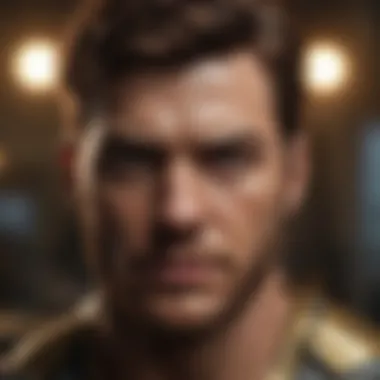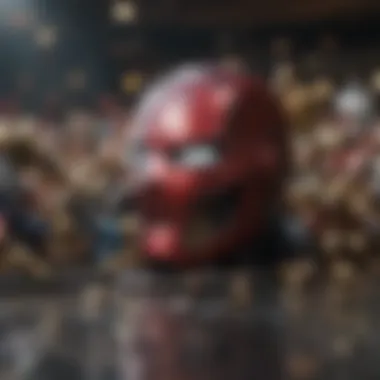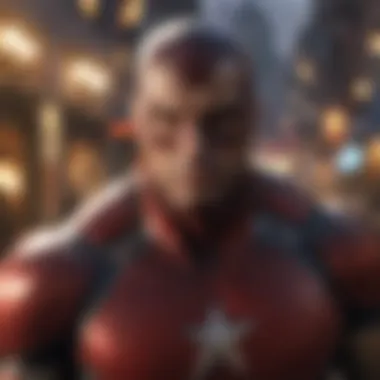Exploring the Impact of Iconic Marvel Films


Intro
The Marvel Cinematic Universe (MCU) stands as one of the most influential and lucrative franchises in modern cinema. From its inception with Iron Man in 2008, the MCU has captivated audiences with a blend of engaging storytelling, robust character arcs, and groundbreaking visual effects. This article aims to explore the top Marvel movies that not only pushed the envelope of cinematic artistry but also resonated deeply with audiences across generations.
As we dissect this cultural titan, we’ll take a closer look at the storytelling techniques, the thematic depth, and the character development that have become hallmarks of Marvel films. Additionally, we will evaluate the visual flair that brings these superhero tales to life, setting a standard that many filmmakers strive to emulate.
Overview of Top Marvel Films
Marvel films offer a thrilling mosaic of narratives, characters, and overarching themes that address both personal and societal struggles. From the journey of an egocentric industrialist to the ups and downs faced by a teenage superhero balancing life and responsibilities, these films highlight a broad spectrum of human experience through the lens of fiction.
Each film unfolds a unique story while tying back to the larger MCU, creating a rich tapestry of interconnected narratives. This approach not only keeps audiences engaged but also fosters a sense of community among fans who analyze and predict the outcomes of future movies. What’s more, the influence of these films extends beyond mere entertainment; they explore themes of heroism, sacrifice, and moral ambiguity that resonate on a deeper level.
Plot/Storyline Analysis
Marvel's storytelling is a masterclass in balancing complex narratives with approachable themes. Take Avengers: Endgame, for instance. It meticulously weaves together various character arcs while tackling concepts of loss, redemption, and the eternal struggle between good and evil. The film’s non-linear narrative structure invites the audience not just to watch but to engage emotionally, prompting reflections on time and consequence.
Consider also the emotional gravity found in Black Panther, a film that dives deep into identity and heritage. The conflicts present are not merely physical but deeply ideological, challenging audiences to think critically about issues such as power dynamics and cultural pride. Such critical examinations elevate these films beyond simple escapism.
Character Development
Character arcs are the heartbeat of these narratives. Tony Stark's evolution from a self-absorbed billionaire in Iron Man to a self-sacrificial hero in Endgame is a prime example. This growth captures the audience's imagination and shapes their emotional investment in events within the MCU. Moreover, supporting characters such as Natasha Romanoff and Steve Rogers add rich layers to the story, making the universe feel expansive and lived-in.
One cannot ignore Erik Killmonger in Black Panther, whose motivations are both relatable and tragic, prompting viewers to question their allegiances. Each character is crafted with discernment, offering a multifaceted perspective on heroism and villainy.
Visuals and Effects
When it comes to visuals, Marvel takes cinematic artistry to another level. The spectacular effects in films like Doctor Strange redefine the boundaries of creativity, immersing audiences in surreal dimensions that defy the laws of physics. The blend of CGI and practical effects presents a dizzying yet cohesive experience that leaves a lasting impression.
Spider-Man: Into the Spider-Verse exemplifies innovation in visual storytelling, utilizing a unique animation style that mimics comic book art. This choice not only enhances the narrative but also reflects the cultural significance of the character and his roots.
In summary, the top Marvel films showcase a remarkable synergy of narrative depth, character complexity, and visual splendor. Whether you're a casual viewer or a hardcore fan, these films offer something for everyone—artistry that resonates on an emotional, cultural, and intellectual level. This exploration reveals why Marvel continues to redefine cinematic standards, providing a deep appreciation for the artistry behind its success.
"Marvel films have become a cultural phenomenon, intertwining storytelling with societal reflection."
As we journey through this deep dive into Marvel movies, let’s unravel the intricacies that have led to their iconic status, examining not just the films, but also their broader implications in today's world.
Understanding the Marvel Cinematic Universe
The Marvel Cinematic Universe, or MCU for short, has become a cultural phenomenon that goes beyond mere entertainment. Its significance lies not only in its box office success but also in its profound impact on storytelling in cinema. Understanding the MCU is crucial for grasping how its films have reshaped the landscape of modern movies, serving as a blueprint for future franchises. We’ll explore various facets of this universe: the origins, the evolution of storytelling techniques, and the overall significance in today's film industry.
Origins of the Marvel Franchise
The roots of the Marvel franchise stretch back to the 1930s, originating from the creative minds at Timely Publications, which later evolved into what we know as Marvel Comics. The debut of characters like the Human Torch and Sub-Mariner laid the groundwork for an expansive universe. Fast forward to the 1960s, and Stan Lee, along with artists like Jack Kirby and Steve Ditko, revolutionized comic books with iconic characters such as Spider-Man, Iron Man, and the X-Men. This era marked a turning point as superheroes became more relatable, grappling with human flaws and societal issues.
In 2008, the MCU was born with "Iron Man", kickstarting a meticulously planned cinematic journey that featured interconnected storylines. The genius behind this approach is evident—creating a shared universe allows for complex narratives where characters can evolve over multiple films, engaging viewers on a deeper level. Moreover, the MCU's strategy of teasing future films through post-credit scenes became a hallmark of franchise filmmaking, setting a higher bar for audience expectations and involvement.
The Evolution of Marvel Storytelling
Marvel's storytelling has undergone substantial evolution, reflecting changing audience tastes and societal norms. Initially, stories focused heavily on straightforward hero vs. villain arcs. Over time, Marvel began to incorporate more nuanced themes. The exploration of psychological aspects in films like "The Winter Soldier" highlighted the moral ambiguities faced by heroes and the consequences of their powers. This marked a shift from simplistic narratives to rich, character-driven tales.
Each phase of the MCU introduces fresh ideas. Phase One focused on character introductions, while Phase Two delved into the complexities of teamwork and sacrifice. The arcs are woven meticulously, where each film builds on the previous one, creating a tapestry of interconnected storylines that has captivated audiences worldwide.
"In this universe, you often find that the real battle lies within, not just against the foes outside."
The stakes are elevated further in recent phases where themes of grief, resilience, and identity come to the fore. Characters like Wanda Maximoff showcase profound emotional journeys that resonate with viewers, pushing the boundaries of traditional superhero narratives.
The Significance of the Marvel Cinematic Universe
The significance of the MCU extends beyond its financial triumphs. It has catalyzed cultural conversations—issues of race, gender, and representation have found a voice through its characters. "Black Panther," for instance, not only broke box office records but also ignited dialogues about representation and cultural pride. Furthermore, characters like Captain Marvel and Valkyrie break norms, offering diverse role models for emerging generations.
The MCU also demonstrates the power of storytelling in a global context. Its appeal transcends geographical boundaries, attracting audiences from various cultures and backgrounds. The films often incorporate universal themes such as hope, redemption, and teamwork, allowing diverse audiences to connect on multiple levels.
Lastly, it has shaped industry trends. Studios are increasingly looking at the MCU as a model—the idea of interwoven narratives and connected universes is gaining traction. This shift suggests a new era of filmmaking, where sequels and spin-offs contribute to a broader narrative rather than existing in isolation.
In summation, understanding the Marvel Cinematic Universe is paramount for appreciating its role in the evolution of modern cinema. From its inception to the innovative storytelling methods and significant cultural impact, the MCU is more than a series of films; it's a movement that continues to challenge and inspire filmmakers and audiences alike.
Genre Blending in Marvel Films
The Marvel Cinematic Universe (MCU) is not just a collection of superhero movies; it functions as a vibrant tapestry interwoven with various genres. The importance of genre blending in these films lies in its ability to captivate diverse audiences, showcasing a sort of storytelling that goes beyond mere action sequences. This fusion allows filmmakers to explore complex themes within a familiar framework, offering something for everyone.
Genre blending creates richer narratives, enhancing both character development and emotional resonance. When you combine elements from action, comedy, drama, and even thriller genres, it brings depth to the characters. Viewers can relate to the heroes not only through their superhero missions but also through their triumphs and tribulations in everyday situations.
Some noteworthy aspects that underline the significance of this genre blending in the MCU are:


- Character Depth: Strong characters emerge as more relatable when faced with real-life dilemmas amidst epic battles.
- Audience Connection: Humor lightens intense situations, allowing audiences to engage on multiple emotional levels.
- Innovative Storytelling: By defying traditional genre boundaries, the MCU keeps its storytelling fresh and appealing.
Thus, it is this unique blending of genres that has contributed significantly to the MCU’s success, offering viewers a chance to savor a range of cinematic experiences.
Superhero Archetypes and Their Transformation
When we talk about superhero archetypes within the Marvel films, it's worth noting how these characters have evolved from the simplistic good versus evil narrative. Take Iron Man, for example. Initially perceived as a self-serving billionaire, his character undergoes a nuanced transformation as he grapples with the consequences of his actions. This kind of development extends beyond just Iron Man; characters like Thor and the Hulk have also faced personal trials that redefine their identities.
By showcasing more multidimensional figures, Marvel’s films challenge traditional superhero norms. Rather than presenting heroes as infallible paragons of virtue, we see them struggle with fears, vulnerabilities, and moral dilemmas. This shift not only breathes life into the characters but also invites audiences to engage more deeply with their journeys. It breaks the mold by saying superheroes can grow, learn, and, at times, fail.
Action, Comedy, and Drama: A Balanced Approach
The MCU is adept at weaving action with humor and dramatic themes, creating a balanced approach that has become its hallmark. Consider "Guardians of the Galaxy," which stands as a prime example of this blend. It combines explosive action set pieces with laugh-out-loud moments and emotionally charged scenes involving loss and redemption.
Each genre level serves a purpose:
- Action keeps audiences on the edge of their seats and showcases the larger-than-life aspects of these characters.
- Comedy offers a breather amidst tension, establishing a relatability factor that resonates with viewers. Quips and situational humor help humanize the characters.
- Drama instills a sense of gravitas, allowing for exploration of profound themes like sacrifice, family, and friendship.
This layered storytelling mechanism is integral to the Marvel films' universal appeal. By not sticking to just one genre, the MCU ensures that viewers leave the theater with a mix of emotions, making them think long after the credits roll.
Marvel's ability to seamlessly blend genres creates a unique cinematic experience that captivates a wide range of audiences. This multifaceted approach is what sets the MCU apart.
Key Films That Defined the Genre
The Marvel Cinematic Universe has given us films that are not just entertaining but have also served as cultural touchstones. These movies have transformed the perception of superhero films, elevating them from comic book adaptations to serious cinematic offerings worthy of critical acclaim. Here, we will explore some pivotal films that have shaped this genre, showcasing their unique elements and the influence they wield in the movie industry today.
Iron Man: The Foundation Stone
When Iron Man hit the screens in 2008, it was like a breath of fresh air in the film industry. Not only did it mark the beginning of the Marvel Cinematic Universe, but it also set a new standard for superhero films. Starring Robert Downey Jr. as Tony Stark, the film introduced audiences to a flawed yet charismatic character who became the face of the franchise.
The film's strength lies in its storytelling and character development. Stark’s journey from a self-absorbed millionaire to a selfless hero highlights the themes of redemption and responsibility. The film's use of cutting-edge special effects brought Stark's technology to life, making it relatable and captivating. The seamless blend of humor and action kept viewers engaged, while its end credits tease left audience wanting more.
Iron Man didn’t just open the door to a universe of superheroes; it established a formula that many subsequent films would follow—the balance between personal stakes and larger-than-life action.
The Avengers: A Cinematic Milestone
Avengers, released in 2012, was nothing short of a cinematic milestone. It showcased Marvel’s bold idea of bringing multiple superheroes together in one film, a concept before considered too ambitious for the big screen. The result was a movie that not only captured the imagination of fans but also broke box office records worldwide.
One of the significant aspects of The Avengers is its ability to blend multiple character arcs into a cohesive narrative. Each Avenger brings their unique personalities and conflicts, providing depth to the story. The dynamics between these characters, such as Iron Man's wit clashing with Captain America's seriousness, created moments that enhanced their interactions.
Furthermore, the film's action sequences were choreographed with precision, making each battle thrilling and visually stunning. The way it wrapped up various story threads from earlier films was particularly satisfying. Avengers didn’t just redefine the superhero genre; it laid the groundwork for ensemble casts, influencing filmmaking and storytelling for years to come.
Black Panther: Cultural Impact and Representation
Black Panther burst onto the scene in 2018, shattering expectations and illustrating the power of representation in cinema. Directed by Ryan Coogler, the film explores themes of identity, heritage, and responsibility within the context of a vibrant African culture, delivering a story that resonates across different demographics.
Wakanda, as a fictional nation, fosters both advanced technology and a deep sense of community, differing from the usual depictions of Africa in media. This setting allowed the film to address issues of race and identity while celebrating African culture—a concept that was revolutionary for mainstream cinema.
The character journey of T'Challa, played by Chadwick Boseman, showcases the struggles of leadership, legacy, and unity against the backdrop of global tension. The representation of strong female characters, like Shuri and Nakia, also turned the narrative on its head, showing that heroism comes in many forms. Black Panther shifted the conversation on representation and has become a symbol for diversity in the film industry.
Infinity War and Endgame: The Climax of a Saga
The two-part conclusion to the Infinity Saga, Infinity War and Endgame, portrays the culmination of years of storytelling and character arcs across multiple films. Released in 2018 and 2019, these films brought together nearly every character introduced in the Marvel Cinematic Universe, making it an unprecedented crossover event in cinematic history.
Infinity War dives into themes of sacrifice and desperation, presenting characters facing overwhelming odds against Thanos, a villain with motives that, while seen as malevolent, are rooted in a twisted philosophy. This complexity adds layers to the narrative, forcing heroes into morally grey decisions.
Endgame was particularly powerful as it tackled grief and loss head-on. The emotional weight of the film hit home as it explored the consequences of the events leading up to it. Characters like Iron Man and Captain America undergo significant growth, culminating in a sense of closure that resonates with audiences emotionally.
Both films are testaments to the art of filmmaking, blending intricate plots while maintaining coherence—a feat that many argue has never been achieved in a single film. They not only changed the way stories are told in Hollywood but also set box office records that may stand for years to come.
"Marvel movies have redefined what it means to be a fan and a filmmaker in modern cinema. Their impact goes beyond entertainment."
Themes Explored in Marvel Narratives
When delving into the narratives of Marvel films, it’s essential to recognize that their depth transcends mere entertainment; they are a lens through which viewers can examine complex themes that resonate on both personal and societal levels. Marvel’s storytelling embraces a spectrum of experiences, making its films relatable to a broad audience. This section explores the themes of identity and self-discovery, power and responsibility, as well as diversity and inclusion, illustrating their crucial role in shaping the emotional and intellectual connections fans develop with the Marvel Cinematic Universe.
Identity and Self-Discovery
At the heart of many Marvel stories lies the journey of identity and self-discovery. Characters often grapple with who they are and what they stand for. Take Peter Parker, for instance; the struggle between his dual identity as a high school student and Spider-Man forces him to confront his responsibilities and the expectation that comes with his powers. This exploration resonates with viewers, particularly younger audiences, navigating their own identities in the face of external expectations.
Another notable example is Thor, who embarks on a profound journey that leads him to question his worthiness. The arc of his character reflects the broader human experience of evolution and growth in spite of failures.
"The greatest power, often, is the ability to understand oneself."
In essence, these narratives prompt audiences to reflect on their lives, pushing them to ask essential questions about their uniqueness and where their true allegiances lie. In this way, Marvel is not just delivering superheroes but facilitating a reflective dialogue about self-identity.


Power, Responsibility, and Morality
Marvel films often tackle the intricate relationship between power, responsibility, and morality. The very mantra of Spider-Man, "With great power comes great responsibility," serves as a guiding principle through numerous films. It’s a reminder that power is not inherently good or evil; it is the choices made by those who hold it that shape outcomes.
Characters like Wakanda’s T'Challa embody this idea. His ascent to king of a technologically advanced nation brings forth the moral dilemma of protecting his people while engaging with the wider world. The film Black Panther intricately weaves these themes, prompting audiences to contemplate their own responsibilities in a globalized society.
Moreover, Vision and Scarlet Witch, during their intricate relationship, challenge the very fabric of morality by questioning if they can rewrite fate or create their own realities without consequence. The moral ambiguity present adds depth to their characters, prompting rich discussions among viewers.
Diversity and Inclusion in the Marvel Universe
Marvel's commitment to representing a broad spectrum of identities and cultures is evident in its more recent films. With characters like Shang-Chi, Black Panther, and the inclusion of strong female leads such as Captain Marvel and Natasha Romanoff in her solo outings, Marvel reflects societal diversity and advocates for inclusion. These narratives provide heroes from varied backgrounds, enabling viewers from all walks of life to see parts of themselves mirrored on the big screen.
This evolution not only makes for richer storytelling but also encourages a wider range of audiences to engage, ultimately leading to organic conversations about race, gender, and representation. Marvel's push towards inclusivity demonstrates their acknowledgment of the complexities of human experiences, promoting empathy and understanding.
Character Development Across Marvel Films
In the realm of storytelling, character development acts as the backbone, holding together intricate narratives while breathing life into the characters that grace the screens. The Marvel Cinematic Universe (MCU) exemplifies this principle consistently, marrying depth and dynamism in its portrayals. By diving into characters’ pasts, desires, and transformations, these films draw audiences into a deeper emotional experience. The importance of character growth in Marvel movies cannot be overstated; it not only enriches the plot but also resonates with viewers, allowing them to engage with themes of hope, redemption, and growth.
The Evolution of Iron Man
Iron Man's journey is a potent illustration of a character's evolution. Starting as a self-absorbed billionaire playboy, Tony Stark grapples with personal demons, notably his weapons manufacturing legacy that caused widespread destruction. It isn't until he faces captivity that he begins to reexamine his priorities.
- Transformation: Stark’s transition from a frivolous entrepreneur to a responsible hero marks an essential pivot. Each film unveils layers of complexity, showcasing the impact of his choices, whether they lead to triumph or personal sacrifice.
- Key Moments: Significant moments, like his snap decision to sacrifice himself in Avengers: Endgame, crystallize his growth, embodying themes of sacrifice and duty.
The very essence of Iron Man serves as a case study that depicts how profound character growth can anchor a cinematic saga.
Scarlet Witch's Complex Journey
The path of Scarlet Witch, aka Wanda Maximoff, is a labyrinth filled with heartache and struggle. Introduced initially as a pawn in Avengers: Age of Ultron, Wanda's trajectory evolves into a compelling narrative of loss and empowerment.
Wanda’s relationship with her powers is fraught with duality.
- Empowerment and Loss: Through WandaVision, we witness her grappling with grief after the tragic loss of Vision. This exploration allows audiences to empathize with her pain—making her more than just a superhero but a symbol of vulnerability amidst chaos.
- Nuanced Arcs: The writers deftly navigate her transition from victim to villain and even an antihero. Each arc highlights how trauma can shape actions and motivations.
Wanda's portrayal taps into a fundamental truth: individuals are often defined by their experiences more than their powers.
The Antagonists: From Villains to Antiheroes
The classical trope of a villain in Marvel stories has undergone a significant transformation. Villains no longer exist solely to oppose heroes; they serve as reflections of heroes’ flaws, making the narrative more layered.
Take Loki as a prime example. Initially presented as the archetypal villain, his character evolves into an antihero, giving depth to the storylines.
- Redemption Arcs: Characters like Loki exhibit themes of redemption and the quest for identity, as seen in Loki, where he confronts his past choices and seeks understanding rather than chaos.
- Complex Motivations: Antiheroes delve into ethical grey areas, challenging the viewers’ perceptions.
"In many ways, the antagonists in Marvel films are not so different from the heroes; their journeys sometimes mirror what the protagonists go through, leading to a richer narrative tapestry."
The depiction of characters who straddle the line between good and evil allows the storytelling to resonate on a more profound level, inviting viewers to explore their own dualities.
Cinematic Techniques and Visual Storytelling
Cinematic techniques serve as the backbone of any film, and when it comes to Marvel movies, these techniques are crucial in creating immersive experiences for viewers. Marvel has mastered the art of visual storytelling, encapsulating narratives that resonate beyond mere dialogue or plot twists. The synergy between visual techniques and storytelling enriches the viewers' emotional connection with the characters and themes. Key elements in this blend include innovation in special effects, adept cinematography, and powerful soundtracks that amplify the storytelling experience. Each of these elements contributes not just to the spectacle of the films, but also to the deeper meanings behind them.
Innovations in Special Effects
In the realm of film, special effects traditionally augment the visual experience, yet in Marvel films, they often become intrinsic to the narrative itself. For instance, consider the impressive way "Doctor Strange" blends practical effects with CGI, crafting mind-bending realities that reflect the protagonist's internal struggles. Marvel tends to push the boundaries of what’s possible in filmmaking. Techniques like motion capture have allowed actors to physically embody hyper-realistic characters, such as Thanos, resulting in a more believable threat onscreen. The audience feels the impact of these effects, as they are not mere distractions; they serve to enhance the storytelling.
"Special effects are not just what you see, they’re also what you feel. They touch the heart of audiences."
– Visual Effects Supervisor
Cinematography: Crafting Epic Visuals
Cinematography in Marvel movies is about more than just capturing stunning images; it’s about storytelling through visual language. Take, for example, the use of color palettes in "Black Panther": vibrant hues showcase Wakanda's richness while subtly informing viewers about the cultural heritage woven into the storyline. Shot composition often plays with perspectives, placing audiences in the shoes of characters during climactic moments.
Furthermore, the framing of action scenes relies heavily on camera movement. The long takes during battles, as seen in "Captain America: The Winter Soldier," create a visceral immersion that makes the audience feel every punch and kick. Each frame is carefully crafted to draw the audience into the Marvel Universe, making them active participants rather than passive viewers.
Soundtrack and Score: Enhancing the Experience
The influence of a well-composed score in film cannot be overstated, and Marvel has enlisted remarkable composers to add depth to their narratives. Hans Zimmer’s contribution to "Batman v Superman" may have defined an era, but Marvel’s use of soundtracks—like the iconic tunes in "Guardians of the Galaxy"—evoke nostalgia while also defining character moments. The song choices serve a dual purpose: they not only entertain but also reflect the personalities of the characters.
Moreover, the score does more than just underline the action. It highlights emotional arcs, as seen in "Endgame," where the score grows more introspective during pivotal character revelations. This harmony between image and sound transforms moments into unforgettable experiences.
In essence, sound and visuals coalesce to create a rich tapestry that captivates audiences, drawing them further into the unique world of Marvel films.
The Global Influence of Marvel Movies


The Marvel Cinematic Universe (MCU) has carved a significant niche not just in filmmaking but also in global culture. Its tentacles stretch far and wide, impacting economies, societal values, and even international relationships. This influence goes beyond box-office numbers and encompasses how the stories resonate worldwide, shaping perceptions about heroism, diversity, and community engagement. Let's delve deeper into these aspects to understand the full breadth of Marvel's impact.
Box Office Success and Economic Impact
Marvel movies are a powerhouse at the box office, bringing in billions of dollars across various markets. For instance, as of recent figures, Avengers: Endgame amassed over $2.798 billion, making it one of the highest-grossing films ever. This type of success doesn’t just signal audience interest; it’s also a lucrative business model for studios, distributors, and theater chains.
The economic ripples extend beyond the theater itself. For economies that host premieres and major screenings, there's an influx of tourists, eager to catch a glimpse of the glitzy world surrounding these films. Local businesses, restaurants, and merchandising vendors often see a significant boost in sales during such events.
Here's a brief snapshot:
- Ticket Sales: Significant revenue from global box office.
- Merchandising: Sales of toys, clothes, and accessories tied to characters.
- Tourism: Film locations and conventions draw crowds from all over.
- Job Creation: From movie production to retail, a wide array of job opportunities arise.
Cultural Reception Around the World
Not only have Marvel films dominated box office charts, but they've also altered cultural conversations around the globe. Different countries resonate with characters and themes distinctively. For example, Black Panther had a pivotal effect on African representation in cinema, sparking dialogues and pride in various cultures around the continent.
In Europe, the films have often been seen as a blend of American storytelling with local flavor, leading to unique adaptations and fan interpretations. For instance, many European fans have created fan art or films that reflect their local culture through the lens of the MCU. Countries like Brazil and India have produced vibrant fan theories and localized content that often honors not only the superheroes but also their importance in contemporary narratives.
The cultural impact spreads in numerous ways:
- Representation and Identity: Characters like Scarlet Witch and Black Panther have initiated discussions around diversity and representation in film.
- Fan Engagement: Global fandom creates a sense of community where fans from different backgrounds unite over shared interests—be it through forums on Reddit or fan pages on Facebook.
- Influence on Local Cinema: Marvel's success has prompted filmmakers worldwide to explore superhero genres, driving new narratives and styles.
"Marvel's films don't just entertain; they also challenge and inspire. The stories linger on long after the credits roll."
As we analyze the global influence of Marvel movies, it's clear they serve as more than just entertainment; they act as cultural artifacts that reflect, challenge, and enrich social dialogues across various societies worldwide. Understanding these elements brings depth to our appreciation of the MCU, illustrating how interconnected our world has become through shared storytelling.
Viewer Engagement and Community
In the realm of Marvel films, viewer engagement isn't just a side note. It's the lifeblood of the franchise, fostering a rich and enthusiastic community that thrives on interaction, creativity, and shared experiences. The importance of this engagement can’t be overstated. It transforms viewers from passive consumers into active participants. This communal experience fuels discussions, theory crafting, and even creates a culture where fans feel like they belong.
Marvel's success isn't solely due to its impressive visuals or action-packed sequences; it stems from how the films resonate with audiences on deeper levels. Fans eagerly dissect plot lines, character arcs, and hidden Easter eggs. This delight in uncovering layers is where the community aspect shines. Such engagement fosters connections among fans, creating bonds that often transcend geographical boundaries.
Moreover, upcoming films become a topic of conversation long before they hit theaters. Rumors and speculation about plot twists or character returns create a ripple, sending fans into a flurry of excitement. Engaging in speculation adds a personal stake to watching the films, as even a casual observer may become a passionate theorist.
The Benefit of Community Involvement
- Shared Knowledge: Fans exchange interpretations and ideas. With many discussions happening on platforms like Reddit, several subreddit communities form around specific movies or characters. This exchange of ideas enhances the viewing experience and can even lead to a deeper understanding of the narratives.
- Cultural Impact: Marvel movies often incorporate social themes. Engaging jointly with the messages has a remarkable effect, as fans champion causes connected to their favorite characters. The discussions resonate beyond cinema and into real-world implications.
- Creative Contributions: Community engagement often gives rise to fan art and fan fiction. This creative output further deepens the connection viewers have with the films, as they explore narratives from innovative angles and give new life to beloved characters.
"The ability to interpret, speculate, and interact is almost like a rite of passage in the Marvel fandom. When a new film drops, it's not just a movie outing; it's an event that demands a collective response."
Overall, viewer engagement and community stand as a testament to the films' impact. The connectedness of fans serves to inspire optimism about the future of Marvel's narrative journey.
Fan Theories and Speculation
Fan theories and speculation play an essential role in shaping the viewing landscape of Marvel films. Fans take to various platforms, from Reddit to Facebook, dissecting every frame and hint dropped in trailers. The intricate web of theories creates a buzz, allowing fans to share their wildest ideas and predictions.
Theories can be wildly imaginative, ranging from plausible connections between characters to intricate plots about alternate universes. Such speculation encourages fans to engage not just when a new film releases but also throughout gaps between installments, keeping Marvel at the forefront of ongoing discussions. Moreover, the studios have begun acknowledging fan theories, often adding layers to them in subsequent films, thus reinforcing the community's involvement.
The Role of Social Media in Fandom
Social media serves as the pivotal ground for fan interactions within the Marvel community. Platforms like Twitter, Instagram, and TikTok allow fans to express their thoughts, share artwork, and publish theories. A glaring example is when a major Marvel film releases; the conversation explodes, often trending worldwide within hours. It allows fans to express interpretations or opinions quickly, creating a dialogue that reflects diverse perspectives.
Moreover, Marvel’s social media accounts actively engage with their audience, posting content that invites fan interaction. By utilizing polls about characters or sharing behind-the-scenes glimpses, Marvel keeps the community buzzing. The relationship between Marvel and its audience has become symbiotic; audiences are not just viewers but integral parts of the storytelling tapestry.
In essence, viewer engagement, grounded deeply in community, strengthens the bond between fans and the Marvel Universe, assuring that these stories will continue to resonate across generations.
Future Directions of the Marvel Cinematic Universe
As we cruise through the seemingly endless saga that is the Marvel Cinematic Universe (MCU), it’s crucial to appraise where it’s headed. The films have evolved from standalone superhero flicks to a sprawling interconnected universe that now serves as a cultural touchstone. In this section, we shall explore the importance of understanding the future directions of the MCU, pointing out specific elements that shape its ongoing narrative.
In a world where audience tastes are instead fickle, Marvel's ability to adapt has stood as a hallmark of its success. The anticipation surrounding upcoming projects not only stirs excitement among fans, but it also provides a vital link between the franchise and its viewers. Marvel’s capacity to unearth fresh stories while remaining tethered to its roots is what keeps its narrative appealing.
Upcoming Projects and Their Anticipation
Several upcoming projects have generated buzz that rivals the excitement surrounding blockbuster releases. Each new title brings with it a sense of anticipation that’s almost palpable. The announced films and series such as "Blade," "Fantastic Four," and the continuation of the "Thunderbolts" saga are just the tip of the iceberg. Not to mention, the various Disney+ shows further expand Marvel’s narratives, leading viewers to settle into a rich universe that continually unfolds.
Some key elements driving this anticipation include:
- Diverse Storylines: Each project promises to explore different aspects of the Marvel Universe. For example, Blade introduces a darker tone, while Fantastic Four may lean into more part science fiction, part human drama.
- Returning Characters: The ability to bring back fan favorites keeps viewers engaged. Characters like Daredevil and Kingpin have already made appearances in this connected universe, stirring excitement for more crossovers.
- Building New Arcs: Every film is an opportunity to launch new story arcs, often leading to team-ups or spin-off series. This allows Marvel to venture into lesser-known comics and characters, keeping all fans on their toes.
"In Marvel, every end is a new beginning. The story never truly ends; it expands."
Adapting to Changing Audience Expectations
The ever-shifting landscape of viewer expectations presents another crucial challenge for the MCU. With the rise of streaming services and more diverse media consumption habits, Marvel faces the task of not just retaining its audience, but actively engaging them with innovative storytelling approaches.
One way Marvel adapts is by incorporating themes that resonate with modern viewers. The variety of genres explored – from political thrillers to deeply personal narratives – allows for a mixing pot of elements that cater to broader tastes.
Moreover, the use of social media for gauging audience reactions can’t be overstated. Marvel often taps into platforms like Reddit and Facebook to understand what fans are craving. This means they can tweak narratives, focus on characters that resonate most with viewers, and even bring story elements back for a second glance.
As Marvel navigates through these future projects, keeping in tune with their audience's evolving interests proves essential. As the landscape changes, so must the universe that has captured hearts across the globe. Being flexible enough to embrace new ideas while keeping the essence of the Marvel legacy alive is what will ensure continued success in the cinematic universe.















